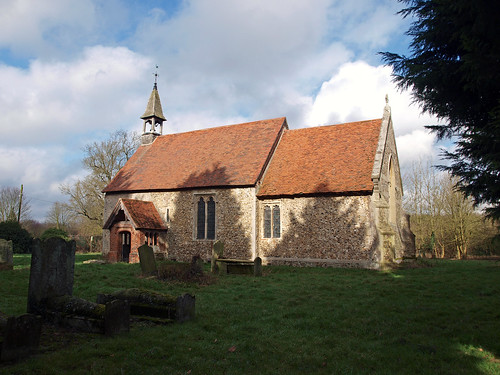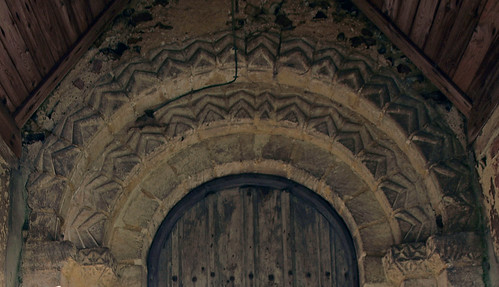The church is redundant nowadays and therefore locked but is really rather beautiful or perhaps its the setting - probably both. It's dedication has been lost in the mists of time (it was only closed in the late 80's surely the dedication must be still known to someone! Searching Flickr gives me one suggestion that it is St Mary the Virgin) and a subsequent reading of Mee's entry makes me wish I could get inside for a last look at what must be fading glory.
CHURCH. Nave, chancel and tiny C19 bell-lantern. On the N side a Norman window and a plain Norman doorway, on the S side also a Norman window and a doorway with two orders of columns with one-scallop capitals, decorated abaci and zigzag arches. The belfry rests on four C15 posts with two arched braces. - PULPIT. Plain C17. - DOOR. C12 ironwork on the N door. - STAINED GLASS. Figure of a Saint, C14, N window. - PLATE. Cup and Paten of 1639.
MASHBURY. A little place, very lonely, it has a small Norman church altered by the 15th century builders, who gave it a new chancel arch and a new east wall. Roman bricks are in the walls with two Norman doorways, one sheltered by a handsome Tudor porch, the other framing a remarkable old door which has kept its battens and hinges from the 12th century. There are two small Norman windows, 15th century beams supporting a modern bell-turret, a panelled 17th century pulpit, and a series of paintings over the altar showing the Nativity, Simeon in the Temple, and Our Lord healing the sick, all in watercolour by William Hole, who is remembered for his wall-paintings in the National Gallery at Edinburgh. A 500-year-old chest is strong with bands of iron and seven hinges, and there are fragments of old glass showing a saint from the 14th century and faces of leopards from the 16th.
A mile away we come to Baileys, a Tudor house with three lovely gables, its porch sheltering a doorway bearing the date 1614.
Flickr set.



No comments:
Post a Comment